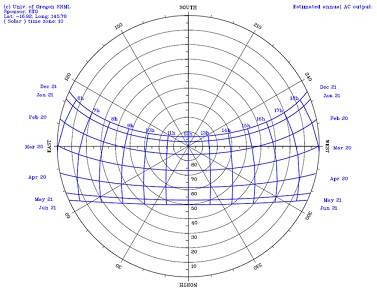Reference no: EM132615629
An energy company hires an engineer to size a solar PV roof top system off-grid in Cairns (16.9186° S, 145.7781° E, GMT+10) to supply a household daily average energy demand of 12 kWh/day, assumed constant during the year. The sun irradiations at summer solstice, winter solstice and at the equinoxes and the average temperatures during the year are given in Table 1. Additionally, a solar water heater needs to be designed to keep a pool of 8 (length)x4(width) x1.5(depth)m not below 28 ?C all year around (recall that 1 m3 =1000 L).The following systems specifications are chosen. Modules of rated power in standard conditions (1 kW/m2 , 25?C operating temperature, AM1.5) of 350W each are chosen. The width of each module is 992 mm and length 1650 mm. The temperature power reduction of the modules is -0.35%/ºC of difference from the module temperature (consider Tmodule = Tambient + 25ºC), while other causes of power derating in the final PV system provide a total power derating factor of 0.72. The solar water heater specifications efficiency is ?=0.75-0.5×(Ti-Tamb)/G. The inlet temperature Ti in winter is assumed 26 ? C.
|
|
Horizontal collection MJ/m2
|
Titled at latitude angle
MJ/m2
|
|
|
Summer solstice (December)
|
23.5
|
21.04
|
|
|
Winter Solstice (June)
|
15.15
|
18.9
|
|
|
Equinox March
|
21.59
|
22.05
|
|
|
Equinox September
|
20.8
|
22.3
|
|
|
Statistics
|
Mar
|
Jun
|
Sep
|
Dec
|
Annual
|
|
Mean (ºC)
|
31.5
|
26.6
|
28.35
|
31.95
|
29.8
|
|
Lowest (ºC)
|
30.2
|
25.7
|
28.6
|
30.8
|
29.4
|
|
Highest (ºC)
|
32.8
|
27.5
|
28.1
|
33.1
|
30.1
|
Determine:
1. The design month/day of both PV and water heater systems and the PSH, chose if tilted at latitude angle or on horizontal plane, justify the choice.
2. The length of the day of the design month (either Summer solstice, winter solstice or Equinox)
3. The altitude of the Sun at solar noon at design day
4. The standard time at solar noon of the design day (neglect EoT and day light savings)
5. The average irradiance from the sun on the design month/day as in 2.
PV system
6. The total capacity of the PV system (number of modules) as per power installed given the energy demand.
7. The annual capacity factor of the PV system (consider the Annual energy production based on annual average PSH and total derating factor as calculated in 6.
8. The efficiency of the PV system at operating condition for the design month/day as above. (tip: efficiency=rated power/power from the sun, consider the rated reduced by the temperature derating factor and as power from the sun the average irradiance).
9. Assume the PV system costs 1.4$/W, the annual maintenance cost is 5% of the capital cost, the discount rate is 5% and 20 years life, determine the cost of the electricity produced by the PV system (consider the annual costs including the capital recovery cost)
10. Assume that you have 5 PV panels each of 4 modules for a total length of each panel of L=1.65 m. The panels are titled at latitude angle and facing north. Which is the minimum distance (Y in the figure 1) from one panel to another you need to avoid shading during all year? (consider sun position at winter solstice at 10am, read altitude and azimuth on the Sun Chart below) .

Figure 1 Lay out of 2 exemplary panels.
11. Calculate the altitude and azimuth angles of the point A and B on the panel with respect to point O.
|
Point
|
Altitude
|
Azimuth (from North)
|
|
A
|
|
|
|
B
|
|
|
12. Draw the altitude and azimuth angles of the points A and B on the panel with respect to point O on the Sun chart of Cairns below at design day

Solar water heater System
13. What is the efficiency of the solar water system at the design day? (tip: determine the average irradiance from irradiation at design day and the length of the day and consider the ambient temperature the lowest)
14. What is the total area of the collectors required to satisfy the need of having the swimming pool always at least at 28? C? Given that each collector is about 3 m2, how many collectors are needed?